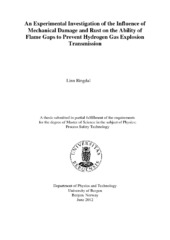An Experimental Investigation of the Influence of Mechanical Damage and Rust on the Ability of Flame Gaps to Prevent Hydrogen Gas Explosion Transmission
Master thesis
Permanent lenke
https://hdl.handle.net/1956/6566Utgivelsesdato
2012-05-31Metadata
Vis full innførselSamlinger
Sammendrag
The present work investigates the influence of rusted and mechanical damaged flame gaps, and the ability of these flame gaps to prevent a hydrogen gas explosion transmission between an inner and outer explosion chamber. An explosion chamber intended for preventing such an explosion transmission between an inner and outer explosive atmosphere is called an Ex'd' enclosure. In the industry there are many potential ignition sources that could be a threat in an explosive atmosphere, as an explosion may occur if being ignited. Ex'd' enclosures are designed to surround the potential ignition sources and to protect a possible internal explosion from spreading to the outer environment. Ex'd' enclosures have certain design requirements specified in the international standards IEC. The design criteria that was examined in this work is (IEC 2007a)'s requirement which states that the mean surface roughness of the flame gap opening shall be less than 6.3 μm. The international standards also require that any damaged flame gap surface must be restored to the original state. However, the standards have no definition of what damages are considerable large enough for having to be restored to the original quality. As a result of this lack of guidance, even minor rust or mechanical damage of the flame gap surfaces must be repaired, which is a time consuming and expensive procedure. The purpose of the present research is, due to the lack of damage ranking definition, to examine what effect different damages have on the safe gap. To be able to conclude about the importance and effect of the damage, one must have a characteristic value for each slit to compare the results. The characteristic value used in this work is the maximum experimental safe gap, MESG, which is a measure of the largest gap opening that does not generate a re- ignition on the outside of the Ex'd' enclosure. An increase in MESG value does therefore imply an increased efficiency of the safe gap. The MESG value is individual for each explosive gas, and will vary as the surfaces of the flame gaps are changed. Similar experiments have previously been performed with propane as the explosive gas, but the present work is carried out with hydrogen as the explosive gas. The present work has also considered the effect of different time periods of rust formation. Six slits were set at sea side for one month and six others for two months. Rusted slits shall, according to the stardards, be restored to the initial state. But results show that corrosion actually increases the efficiency of the safe gap. The efficiency of the safe gap also increases with increased rust formation on the slit's surfaces. The mechanical damaged flame gaps were applied grooves of various depths and various widths to their surfaces. All grooves were crosswise, thus in the opposite direction of the gas flow that was being pushed through the opening by the internal explosion. The MESG values of the mechanical damaged slits turned out to be larger than the undamaged slits' MESG values, which refers to an increased efficiency of the safe gap. The overall conclusion from this investigation is that damaged surfaces of flame gaps do not reduce the efficiency of the safe gap. Neither rusted nor significant mechanical damaged flame gap surfaces reduce the efficiency of the safe gap. In fact, improvements are observed in all cases. This indicates that the surface roughness requirements of the international standards which states that the mean surface roughness must be less than 6.3 μm, is an arbitrarily chosen value. It is also shown in this study that the temperature of the hot combustion gases is lower after they have penetrated through flame gaps with grooves, rather than after penetrating through an undamaged flame gap. The probability of generating a re-ignition in the secondary chamber through flame gaps with grooves is then decreased as a result of the lower temperature
